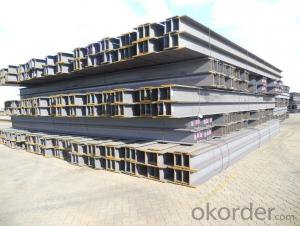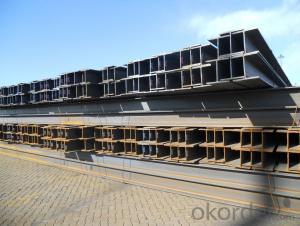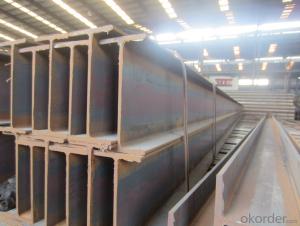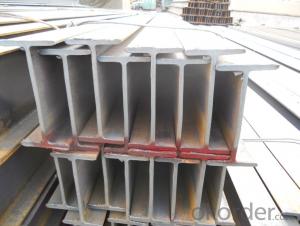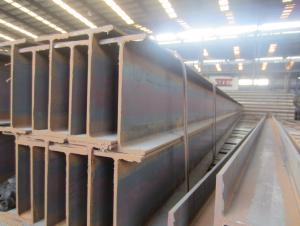JIS Standard Hot Rolled Steel H Beams for Construction
- Loading Port:
- Shanghai
- Payment Terms:
- TT or LC
- Min Order Qty:
- 25 m.t.
- Supply Capability:
- 200000 m.t./month
OKorder Service Pledge
OKorder Financial Service
You Might Also Like
Product Description:
OKorder is offering JIS Standard Hot Rolled Steel H Beams for Construction at great prices with worldwide shipping. Our supplier is a world-class manufacturer of steel, with our products utilized the world over. OKorder annually supplies products to African, South American and Asian markets. We provide quotations within 24 hours of receiving an inquiry and guarantee competitive prices.
Product Applications:
JIS Standard Hot Rolled Steel H Beams for Construction are ideal for structural applications and are widely used inindustrial plants, civil construction, municipal works, oil platforms, bridges, flatbed beams, electrified railway power stand, railway bridges and other light steel structure, super-light H-beam is ideal for containers, mobile homes , all kinds of garage, box-type trains, electrical bracket, various venues, small villa manufacturing etc.
Product Advantages:
OKorder's JIS Standard Hot Rolled Steel H Beams for Construction are durable, strong, and wide variety of sizes.
Main Product Features:
· Premium quality
· Prompt delivery & seaworthy packing (30 days after receiving deposit)
· Can be recycled and reused
· Mill test certification
· Professional Service
· Competitive pricing
Product Specifications:
JIS Standard Hot Rolled Steel H Beams for Construction
Grade: Q195 – 235
Certificates: ISO, SGS, BV, CIQ
Length: 12m, as per customer request
Packaging: Export packing, nude packing, bundled
| H BEAM | ||||||
| size | h (MM) | b (MM) | t1 (MM) | t2 (MM) | Mass: Kg/m | LENGTH |
| 100x100 | 100 | 100 | 6.0 | 8 | 16.9 | 12M |
| 125x125 | 125 | 125 | 6.5 | 9 | 23.6 | 12M |
| 150x75 | 150 | 75 | 5.0 | 7 | 14.0 | 12M |
| 148x100 | 148 | 100 | 6.0 | 9 | 20.7 | 12M |
| 150x150 | 150 | 150 | 7.0 | 10 | 31.1 | 12M |
| 175x90 | 175 | 90 | 5.0 | 8 | 18.0 | 12M |
| 175x175 | 175 | 175 | 5.0 | 11 | 40.4 | 12M |
| 198x99 | 198 | 99 | 4.5 | 7 | 17.8 | 12M |
| 200x100 | 200 | 100 | 5.5 | 8 | 20.9 | 12M |
| 194x150 | 194 | 150 | 6.0 | 9 | 29.9 | 12M |
| 200x200 | 200 | 200 | 8.0 | 12 | 49.9 | 12M |
| 200x204 | 200 | 204 | 12.0 | 12 | 56.2 | 12M |
| 248x124 | 248 | 124 | 5.0 | 8 | 25.1 | 12M |
| 250x125 | 250 | 125 | 6.0 | 9 | 29.0 | 12M |
| 244x175 | 244 | 175 | 7.0 | 11 | 43.6 | 12M |
| 250x250 | 250 | 250 | 9.0 | 14 | 71.8 | 12M |
| 250x255 | 250 | 255 | 14.0 | 14 | 81.6 | 12M |
| 298x149 | 298 | 149 | 5.5 | 8 | 32.0 | 12M |
| 300x150 | 300 | 150 | 6.5 | 9 | 36.7 | 12M |
FAQ:
Q1: Why buy Materials & Equipment from OKorder.com?
A1: All products offered byOKorder.com are carefully selected from China's most reliable manufacturing enterprises. Through its ISO certifications, OKorder.com adheres to the highest standards and a commitment to supply chain safety and customer satisfaction.
Q2: How many tons of steel products could be loaded in containers?
A2: Usually the steel products are delivered by bulk vessel because of the large quantity and the freight. However, there are no bulk vessel enter some seaports so that we have to deliver the cargo by containers. The 6m steel product can be loaded in 20FT container, but the quantity is changed according to the size, usually from 18tons to 25tons.
Q3: How soon can we receive the product after purchase?
A3: Within three days of placing an order, we will arrange production. The normal sizes with the normal grade can be produced within one month. The specific shipping date is dependent upon international and government factors, the delivery to international main port about 45-60days.

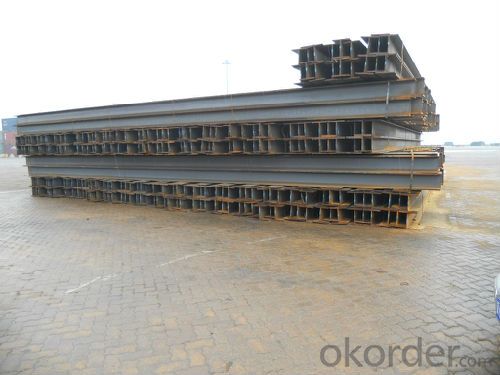
- Q:What are the common defects found in steel H-beams?
- Steel H-beams may have various defects that can be commonly observed. Surface imperfections, including scratches, pits, or dents, are among the most frequent defects. These imperfections may arise during the manufacturing process or due to mishandling during transportation or storage. Another defect that is commonly found in H-beams is related to welding. Since H-beams are typically created by welding different sections together, improper welding techniques can result in defects like cracks, lack of fusion, or excessive weld spatter. Misalignments are also prevalent defects in steel H-beams. When the flanges or webs of the beam are not aligned properly, it can cause an uneven or twisted shape. Such misalignments can compromise the overall structural integrity of the beam and necessitate corrective actions for ensuring proper functionality. Furthermore, dimensional deviations can be detected in H-beams. These deviations may involve variations in length, width, or height, which can have an impact on the beam's stability and load-bearing capacity. Lastly, corrosion is another defect that may affect steel H-beams, particularly when they are exposed to outdoor or corrosive environments. If the beam lacks proper protection through coatings or if there are gaps in the protective layer, rust formation and deterioration of the steel can occur. In conclusion, it is crucial to inspect H-beams for these common defects to guarantee their quality and structural integrity. Consistent maintenance, appropriate handling, and adherence to manufacturing standards can effectively prevent these defects and ensure the long-lasting performance of the beams.
- Q:Can steel H-beams be used in wastewater treatment plants?
- Yes, steel H-beams can be used in wastewater treatment plants. They are commonly used in the construction of infrastructure such as tanks, channels, and supporting structures due to their durability, strength, and resistance to corrosion. Additionally, steel H-beams can be easily fabricated and installed, making them a suitable choice for wastewater treatment plant applications.
- Q:Can steel H-beams be used in the construction of shopping malls or retail buildings?
- Yes, steel H-beams can be used in the construction of shopping malls or retail buildings. Steel H-beams are commonly used in commercial construction projects due to their strength, durability, and versatility. They provide excellent structural support, allowing for open floor plans and large, open spaces often needed in shopping malls or retail buildings. Additionally, steel H-beams are cost-effective and can be easily fabricated and installed, making them a popular choice in the construction industry.
- Q:Are steel H-beams suitable for structures with irregular shapes?
- Steel H-beams are typically used as structural elements in buildings and bridges due to their strength and versatility. However, when it comes to structures with irregular shapes, the suitability of steel H-beams depends on the specific design requirements and constraints. In general, steel H-beams are a suitable choice for structures with irregular shapes as they offer high structural integrity and load-bearing capacity. They can be used to create complex frameworks and support systems that can accommodate various shapes and configurations. The flexibility of steel allows for customization and adaptation to different architectural designs. That being said, the design and construction of structures with irregular shapes often require careful planning and engineering. The irregularity of the shape may require additional support or reinforcement to ensure structural stability. This can be achieved by combining the H-beams with other structural elements, such as braces or trusses, to distribute the load effectively. It is important to consult with professional engineers and architects who specialize in structural design to assess the suitability of steel H-beams for a specific irregular-shaped structure. They can provide valuable insights and calculations to ensure that the H-beams are appropriately sized and positioned to meet the structural requirements and maintain the safety of the overall structure. In summary, steel H-beams can be suitable for structures with irregular shapes, but their application requires careful consideration of the specific design constraints and the expertise of professionals in the field of structural engineering.
- Q:How do steel H-beams contribute to water conservation in buildings?
- Steel H-beams contribute to water conservation in buildings by reducing the need for excessive water usage during construction. These beams are lightweight yet strong, allowing for the construction of sustainable and efficient structures. As a result, less water is required for construction purposes, leading to overall water conservation in buildings.
- Q:Can steel H-beams be used in railway overpasses?
- Yes, steel H-beams can be used in railway overpasses. They are commonly used in the construction of railway bridges and overpasses due to their high load-bearing capacity and structural strength.
- Q:Can Steel H-Beams be used in architectural features or decorative elements?
- Certainly, architectural features or decorative elements can definitely utilize Steel H-Beams. Although primarily known for their structural strength and load-bearing capabilities in construction, H-Beams can also be employed in architectural designs to create distinctive and visually pleasing features. Architects and designers have the ability to integrate H-Beams into the overall aesthetics of a building, such as exposed beam ceilings, mezzanines, or open floor plans. The contemporary and industrial appearance of steel H-Beams can contribute a modern touch to any space. Furthermore, H-Beams can be utilized to fashion decorative elements like staircases, railings, pergolas, or even furniture pieces. Their sleek lines and durable nature make them suitable for both indoor and outdoor applications. In addition to their aesthetic appeal, steel H-Beams offer practical advantages. They possess fire-resistant properties, durability, and require minimal maintenance. Their structural integrity guarantees long-lasting performance and can endure heavy loads, which makes them an ideal choice for architectural features and decorative elements. All in all, Steel H-Beams present a versatile and visually appealing option for incorporating architectural features or decorative elements into a design. Their strength and durability, combined with their modern and industrial appearance, make them an outstanding option for both functional and aesthetic purposes in the field of architecture.
- Q:What are the common surface treatments available for steel H-beams?
- Steel H-beams have a variety of surface treatments available to enhance durability, appearance, and corrosion resistance. Some common treatments include: 1. Hot-dip galvanizing: Immersing the beams in molten zinc forms a protective coating, providing excellent corrosion resistance for outdoor or high-moisture environments. 2. Powder coating: A dry powder is applied to the beams, then heated and fused onto the metal, creating a durable and attractive finish that resists chipping, scratching, and fading. 3. Epoxy coating: This treatment adds a protective layer that resists corrosion, chemicals, and abrasion, making it suitable for industrial settings with harsh substances. 4. Painting: A popular treatment for steel H-beams, painting offers aesthetic appeal and corrosion protection. Beams are primed and coated with high-quality, weather and UV-resistant paint. 5. Shot blasting: Small metallic or abrasive particles are propelled at high speeds onto the beams' surface, removing rust, mill scale, and impurities, leaving a clean and roughened surface for further treatment. Choosing the appropriate surface treatment for steel H-beams depends on specific requirements, including application, environmental conditions, and aesthetic preferences. Factors like cost, durability, maintenance, and expected lifespan should be considered when selecting the most suitable treatment.
- Q:How do you calculate the deflection limits for steel H-beams?
- To determine the deflection limits for steel H-beams, several factors must be considered. Typically, the deflection limits are established by relevant building codes or industry standards. The steps below outline the general process of calculating these limits: 1. Find the applicable building code or industry standard: Building codes or industry standards, such as the American Institute of Steel Construction (AISC) code, usually specify the deflection limits. These codes provide guidelines based on the intended use of the structure. 2. Gather information about the H-beam: Collect the necessary details about the H-beam, including dimensions, material properties, and support conditions. This information can be obtained from the manufacturer or relevant design resources. 3. Calculate the moment of inertia: The moment of inertia measures the beam's resistance to bending. It is determined by the beam's dimensions and geometry. The moment of inertia plays a critical role in determining the deflection of the beam. 4. Identify the applied load: Determine the load or loads that will act on the H-beam. This may include dead loads, live loads, wind loads, or other specified loads according to design requirements. 5. Use the appropriate deflection formula: The choice of deflection formula depends on the type of loading and support conditions. Common formulas include the Euler-Bernoulli beam equation, which assumes linear elastic behavior, and the Timoshenko beam equation, which considers shear deformations. 6. Calculate the maximum allowable deflection: Utilize the deflection formula to input relevant parameters such as applied load, beam properties, and support conditions. Calculate the deflection at various points along the beam and compare these values to the deflection limits specified in the building code or industry standard. 7. Ensure compliance with deflection limits: If the calculated deflection exceeds the specified limits, adjustments must be made to the beam's dimensions, material, or support conditions. This may involve increasing the beam size, using a stronger material, or adding additional support. It is important to note that calculating deflection limits for steel H-beams can be a complex process that may require the expertise of a structural engineer or designer. Adhering to the applicable building codes and industry standards is crucial to ensure project safety and structural integrity.
- Q:Can steel H-beams be used in the construction of theaters or auditoriums?
- Certainly! Steel H-beams have proven to be a valuable asset in the construction of theaters and auditoriums. Their strength and durability make them a popular choice in the industry. These beams offer structural support and are frequently utilized as load-bearing components in various building projects. In the case of theaters and auditoriums, where expansive open spaces and lofty ceilings are often desired, steel H-beams can be employed to establish the necessary framework and provide support for the structure. Furthermore, these beams can be easily fabricated and tailored to meet the specific design and structural prerequisites of the theater or auditorium. Overall, steel H-beams are widely favored in the construction field due to their robustness, versatility, and dependability - qualities that make them particularly suitable for the construction of theaters and auditoriums.
1. Manufacturer Overview |
|
|---|---|
| Location | |
| Year Established | |
| Annual Output Value | |
| Main Markets | |
| Company Certifications | |
2. Manufacturer Certificates |
|
|---|---|
| a) Certification Name | |
| Range | |
| Reference | |
| Validity Period | |
3. Manufacturer Capability |
|
|---|---|
| a)Trade Capacity | |
| Nearest Port | |
| Export Percentage | |
| No.of Employees in Trade Department | |
| Language Spoken: | |
| b)Factory Information | |
| Factory Size: | |
| No. of Production Lines | |
| Contract Manufacturing | |
| Product Price Range | |
Send your message to us
JIS Standard Hot Rolled Steel H Beams for Construction
- Loading Port:
- Shanghai
- Payment Terms:
- TT or LC
- Min Order Qty:
- 25 m.t.
- Supply Capability:
- 200000 m.t./month
OKorder Service Pledge
OKorder Financial Service
Similar products
New products
Hot products
Related keywords
